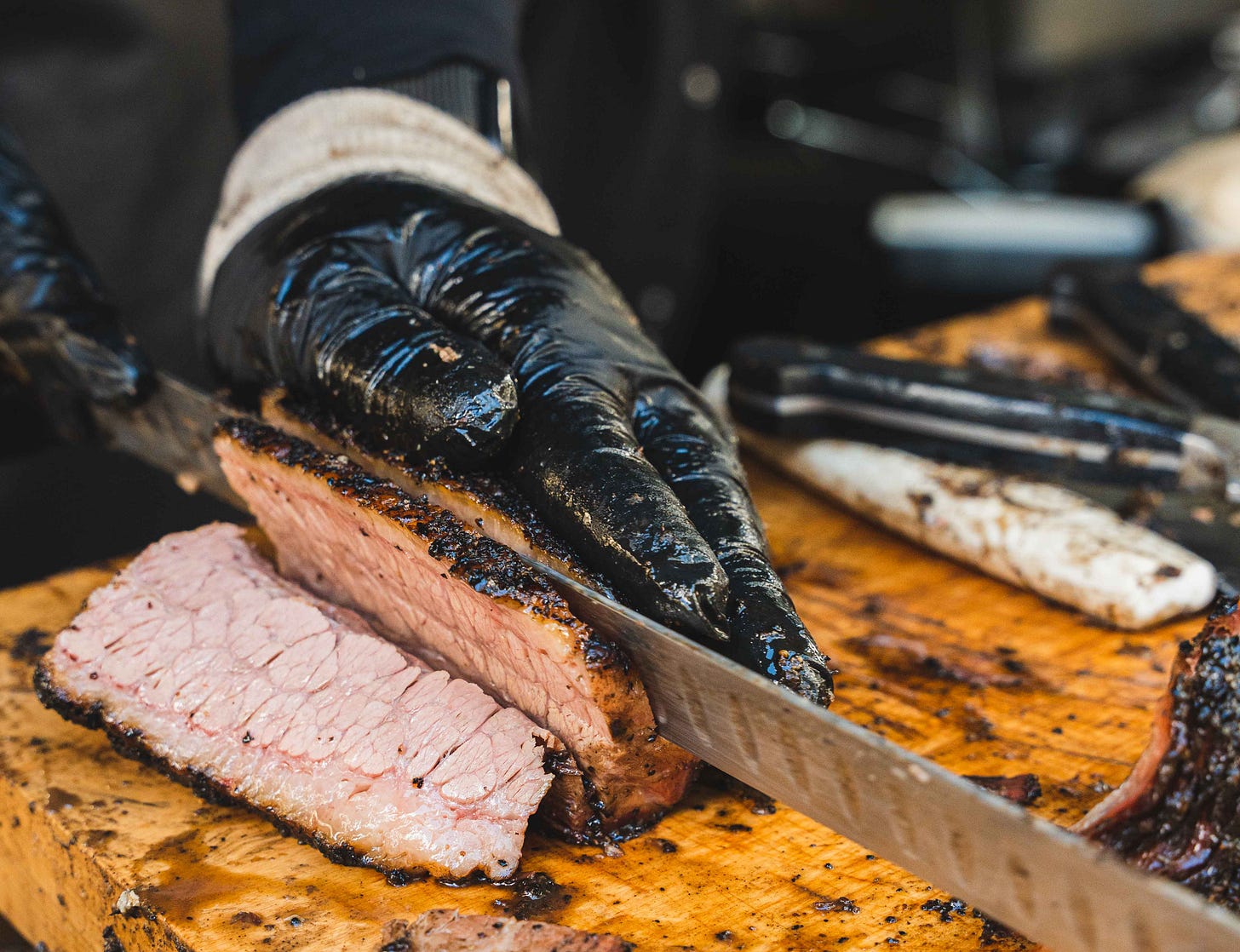The True Cost of Barbecue: Why Your $80 Brisket Doesn’t Add Up
"...it’s about everything else that goes into running a successful barbecue business."
We’ve all seen it before. Someone, somewhere—probably on Reddit—is outraged.
"Why is brisket $30 a pound at my local BBQ joint? I can buy a whole brisket at Costco for $80!"
That argument pops up every time a BBQ restaurant posts its menu, and it never fails to get the pitmasters shaking their heads. What these self-proclaimed cost analysts don’t realize is that BBQ isn’t just about the price of the meat—it’s about everything else that goes into running a successful barbecue business.
From labor and fuel to paper goods and insurance, let’s break down the real cost of serving up that beautifully smoked, melt-in-your-mouth brisket—so the next time someone says, “I could make this cheaper at home,” you’ll know exactly why they’re wrong.
The Meat is Just the Beginning
Yes, a raw brisket at the store might cost $80. But unless you’re eating it raw like a caveman (which we do not recommend), you’re about to rack up a whole lot more expenses before it ever reaches your plate.
Meat Shrinkage: Say Goodbye to Half of It
A typical brisket loses 40-50% of its weight during cooking. That means your 14-pound brisket is realistically yielding around 7-8 pounds of finished product.
Suddenly, that $80 brisket isn’t going as far as you thought. If you’re running a restaurant, you can’t sell the pre-cooked weight. You’re selling the finished, ready-to-eat brisket—which means the actual cost per pound just doubled before you’ve even touched the smoker.
The Labor Factor: BBQ Isn’t Fast Food
Unlike a burger joint that can flip a patty in five minutes, BBQ requires time, patience, and a pitmaster who actually knows what they’re doing.
A brisket takes 12 to 16 hours to cook properly.
That means someone has to be up tending the fire, rotating the meat, and making sure the temperatures stay just right.
Then there’s the prep—trimming the brisket, seasoning it, and getting it ready for the smoker.
And the post-cook—resting it properly, slicing it right, and plating it for service.
That’s a full day’s work just to get one brisket out the door. Are you paying yourself for that time? Because a BBQ business has to.
The Overhead Costs: More Than Just Firewood
Let’s talk about the hidden costs that your $80 brisket at home doesn’t cover.
Wood and Fuel: Running a smoker for 12+ hours isn’t cheap. High-quality post oak, hickory, or fruitwood logs add up fast.
Utilities: Running refrigerators, freezers, dishwashers, ventilation systems, and a constant supply of running water isn’t free.
Insurance: You think you can just start a BBQ restaurant and not have liability insurance? Someone burns their tongue, someone claims food poisoning—you better believe a restaurant needs coverage.
Equipment Costs: That Traeger in your backyard didn’t pay for itself. Now imagine industrial smokers, warming boxes, prep stations, and kitchen space.
Now, let’s talk about something nobody ever thinks about:
The Cost of Napkins, To-Go Boxes, and Paper Towels
A BBQ joint doesn’t just hand you a fork and call it a day.
To-go boxes, napkins, forks, trays, butcher paper—every single tiny item adds to the cost.
Prices on paper goods have skyrocketed. Some BBQ joints have seen a 33% increase in their paper product costs alone.
Add in sauces, pickles, and sides—none of which magically appear for free—and the price tag keeps climbing.
You wouldn’t believe how much money a restaurant spends on basic disposable goods that customers don’t even think about.
Wages and Staffing: The People Behind the Pit
A successful BBQ business isn’t just one guy running a smoker. It takes:
A prep team trimming and seasoning the meat.
A pit crew monitoring the fire and shifting meat during the cook.
A slicing team ensuring every plate gets perfectly cut brisket.
A front-of-house team handling customer service, taking orders, and keeping everything running smoothly.
All of these employees need to be paid. And BBQ labor isn’t like flipping burgers—it requires skill, patience, and expertise.
So, What Should BBQ Really Cost?
BBQ restaurants need to operate at a 3-4x food cost multiplier to stay profitable. That means if a brisket costs them $10 per pound raw, it needs to be priced at $30-40 per pound cooked to cover everything else.
That’s not greed—that’s survival.
A BBQ restaurant that skimps on pricing is a BBQ restaurant that won’t be around for long. And if you want real, craft barbecue—not the mass-produced, pre-sliced stuff sitting under a heat lamp—you have to be willing to pay for it.
The $80 Brisket Myth, Debunked
The next time someone complains about BBQ prices, hit them with the facts:
That $80 brisket isn’t going to serve as many people as they think.
Running a BBQ business means factoring in labor, fuel, utilities, and equipment—things a home cook never considers.
Every little thing—down to the napkins and to-go boxes—has a cost.
A 3-4x food cost multiplier is necessary for a restaurant to stay in business.
So, can you make brisket cheaper at home? Sure—if you’re willing to ignore your time, the hidden costs, and the quality gap between a backyard cook and a professional pitmaster.
But if you want world-class, expertly smoked BBQ that’s worth every bite? You pay for experience.
And that’s why your $80 brisket at Costco is not the same as the brisket you get at a top-tier BBQ joint.
Have you ever tried to break down the true cost of BBQ? Or have you seen someone complain about prices without realizing what goes into it? Drop your thoughts in the comments.



